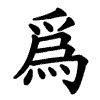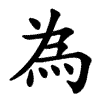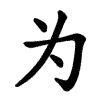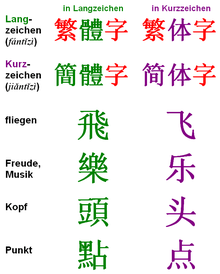Simplified Chinese characters
![]()
This article is about Chinese characters. For abbreviations for plastics, see abbreviation (plastic).
Short characters are the simplified version of the traditional long characters of the Chinese script. As a character variant in the historical development of Chinese character culture, historically transmitted short characters have always existed. Short characters, or more precisely simplified reformed standard characters, also known as simplified Chinese for short, are character forms that the People's Republic of China simplified in the 1950s and declared the official standard. They are now used in mainland China, Singapore and Malaysia, while the long characters are still used in Taiwan, Hong Kong and Macau.
Here, for example, the sign for spelling wèi "for" and wéi "to do; to be; to become something; to be regarded as":
· 
爲 12 strokes: earlier graphic variant of the traditional long character (common historical character variant, Imperial China).
· 
為 9 strokes: today's traditional long character (slightly simplified character variant, Taiwan, Hong Kong, Macau)
· 
为 4 strokes: simplified short character (highly simplified character variant, Chinese character reform 1956, PR China)

Notation with long characters (left) and short characters (right) . Common characters are shown in red.
Designations and names
Short & Long Characters
Short characters are commonly called jiǎntǐzì (簡體字 / 简体字 - "simple character") in Chinese, traditional Chinese characters, commonly known as long characters, are referred to as fántǐzì (繁體字 / 繁体字 - "complex character") in Chinese, or more specifically as zhèngtǐzì (正體字 / 正体字 - "original character") in Taiwan. As a generic term and antonym to long characters, the term short character therefore includes both historically transmitted short characters and all official standard characters of the officially simplified or reformed characters of the government of the People's Republic of China.
Simplified characters
Simplified characters, i.e. characters that have been created by simplifying the original form of a character, often colloquially referred to as short characters in German, are technically correctly called jiǎnhuàzì (簡化字 / 简化字 - "simplified character") in Chinese. All characters officially included by the government of the People's Republic of China in the "Plan for Simplifying the Chinese Script" (漢字簡化方案 / 汉字简化方案, Hànzì Jiǎnhuà Fāng'àn) as a reformed character set belong to this group. Also included in this group are the abbreviated characters, a general term referred to in Chinese as jiǎnbǐzì (简笔字 / 简筆字 - "characters of simplified stroke sequences").
Standard font
Standard characters, in Chinese generally guīfàn hànzì (規範漢字 / 规范汉字 - "regulated / standardized character"), are characters that are officially regulated by the government of the People's Republic of China and recommended for use. These officially released characters as a character set of 8105 characters are published in the Table of General Standard Chinese Characters (通用規範漢字表 / 通用规范汉字表 - "List of General Standard Characters"). For use in modern Chinese everyday life, it includes a character collection (常用字集, chángyòng zìjí - "everyday character collection") with a list of 3500 characters, also officially known as the Category One Character List (一級字表 / 一级字表, yījí zìbiǎo). For use particularly in print or publishing, lexigraphy, and media and communications, the Category Two (二級字表 / 二级字表, èrjí zìbiǎo) character list contains 3000 characters. The character list of category three (三級字表 / 三级字表, sānjí zìbiǎo) with 1605 characters generally includes characters in the field of surnames, toponym, science and technology, as well as educational field of primary school, middle school or secondary and tertiary level as well as common characters in classical Chinese.
History
In January 1956, the government of the People's Republic of China issued the "Plan for Simplifying the Chinese Script" (漢字簡化方案 / 汉字简化方案, Hànzì Jiǎnhuà Fāng'àn), which simplified 515 characters and 54 components of characters. The simplification of characters was one element of the script reform, which was initially intended to popularize the standard language, simplify characters, and eventually replace them with a Latin script. This group of simplified characters published in the first reform are therefore popularly called Yījiǎnzì (一簡字 / 一简字 - "simplified characters of the first reform").
In April 1964, another reform step was taken and the "Complete List of Simplified Characters" (簡化漢字總表 / 简化汉字总表, Jiǎnhuà Hànzì Zǒngbiǎo) was published. It contained 2236 characters.
In December 1977, the Chinese government issued the "Second Plan for Simplifying Chinese Writing (Draft)" (第二次漢字簡化方案(草案 / 第二次汉字简化方案(草案, Dì-èr cì Hànzì Jiǎnhuà Fāng'àn (Cǎoàn)) came out, which simplified another 853 characters and 61 components of characters. However, this draft was widely criticized and hardly implemented. Accordingly, this group of simplified characters published in the second reform is popularly called Èrjiǎnzì (二簡字 / 二简字 - "simplified characters of the second reform").
In 1986, the 1964 list was slightly revised and the 1977 reform was shelved.
In August 2009, the Chinese Ministry of Education published another list (通用規範漢字表 / 通用规范汉字表 - "List of General Standard Characters") of 8300 standardized characters, in which 44 characters slightly changed from the previous standard and some new characters used in given names (e.g.. e.g. 喆, 淼, 堃 and 昇) had been included.
These simplified characters are also used by the government and the Chinese population in Singapore, respectively. In contrast, Taiwan, Hong Kong and Macau, as well as most Chinese living in exile for political reasons, did not introduce the simplifications.
The simplification consisted of standardizing the characters, i.e. eliminating possible variants, and reducing the number of strokes. This was achieved mainly by adopting variants from handwriting into print. The large number of simplified characters (several thousand) is mainly due to the fact that components that occur in many characters (radicals) were also simplified. Officially, the characters were simplified according to the following ten methods:
.svg.png)
The word Hànzì (Chinese characters) in long characters
.svg.png)
The word Hànzì (Chinese characters) in shorthand
Search within the encyclopedia